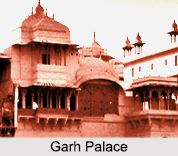 Garh palace, which is situated in Kota, Rajasthan, is a single complex comprising of a number of architectural structures in it. Garh Palace is decorated with beautiful paintings, mirror ceilings and mirror walls and the gardens in it increase the level of its beauty. One of the most eye catching spots of this palace is the Rao Madho Singh Trust Museum in it, which displays the royal grandeur. Garh Palace is also called the city palace.
Garh palace, which is situated in Kota, Rajasthan, is a single complex comprising of a number of architectural structures in it. Garh Palace is decorated with beautiful paintings, mirror ceilings and mirror walls and the gardens in it increase the level of its beauty. One of the most eye catching spots of this palace is the Rao Madho Singh Trust Museum in it, which displays the royal grandeur. Garh Palace is also called the city palace.
History of Garh Palace
It is mostly heard that the palace was constructed in early 1264 C.E. by the prince of Bundi, Jait Singh, who made the palace after killing the ruler Koteya.
Structure of Garh Palace
A cobbled pathway will lead the travelers to the Garh Palace. There are two massive gateways through which the tourists can enter the Garh Palace. One is the Hazari Pol and the other is the Hathi Pol. The latter is worth a mention, which stands with two enormous elephants on the either sides of the gate. These have been carved above the gate and are seen with raised trunks that have been painted resplendently. This particular gate leads to the inner courtyard. It is surrounded by arcades and stables have some outstanding murals and there is a white marble throne used for coronation ceremonies.
Architecture of Garh Palace
There are several apartments within this palace. The most impressive of the palaces is Chattar Mahal, built by Rao Chattar Sal in the year 1660. The palace is characterized by terraces supporting pavilions adorned with recurrent elephant motifs, ornamental brackets, drooping roofs and kiosks. Another gem in the Garh Palace is the Chitra Mahal or the Palace of Paintings. The walls of this mahal are replete with paintings that depict lively battle scenes, charming pastorals, princesses in fancy dresses, romantic landscapes of Lord Krishna, hunting scenes and royal processions.
But what will catch the fascination of the visitors are depictions of the maidens pining for absent lovers. Bundi miniature paintings are known for their sense of design and the dominant colours of green and turquoise blue. Over the years well known people, such as, Rudyard Kipling and Colonel Tod have come here and been completely enthralled by the architectural grandeur.
The best time to visit the place is from November to February, when the temperature is comparatively low.



















